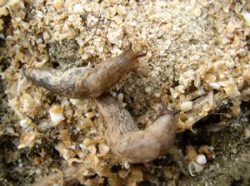
Slug counts increased in May with 40% of the Slugwatch UK monitoring sites showing high levels of slug activity - an alert for potato growers to assess individual field risk now.
Across the 31 Slugwatch UK monitoring sites the average soil population in May rose to 38 slugs per square metre. Bayer slug specialist Dr Richard Meredith says this indicates a healthy over-wintering of slug populations throughout arable areas.
The national picture ranges dramatically though; seven sites are showing minimal soil population activity, six have moderate activity (10 to 30 slugs per square metre) and 12 have high activity (30+ slugs per square metre). May's highest record was 305 at Cock Bevington in Warwickshire and the next three highest sites recorded over 100.
"The first critical application of pellets to potato crops needs to be made before canopy closure for best effect, so potato growers need to be checking individual field risk now with surface trapping," Dr Meredith advises.
Looking beyond the sheer numbers, he says there is also significance in the species and age profiles recorded. "At half of the high risk sites 30% of the slugs found were Round-backed slugs (Arion spp.) - being predominantly subterranean in habit they pose a particular risk to potato tubers.
"Nationally the age profile is 50% juveniles indicating successful spring hatchings, and the potential for further mating and egg-laying by Grey field slugs, which can go through multiple breeding cycles. Populations therefore have the potential to increase as potato crops mature. Finding just one slug per monitoring trap is enough to justify treatment due to the high value of the crop and the low tolerance of slug damage to tubers."
Independent product testing confirms that potato crops are best protected with a few well-timed applications of methiocarb pellets. In a trial conducted by Insect Investigations Ltd last year under high slug pressure, three applications of methiocarb at two to four week intervals, starting just prior to canopy closure, more than halved tuber damage.
Comparison programmes were chosen to test the 'little and often' approach where growers routinely apply reduced rates of metaldehyde pellets from crop emergence. Weekly applications of metaldehyde mini pellets reduced tuber damage by just 30% and six metaldehyde quality pellet applications reduced damage by 36%.
By comparison the methiocarb programme reduced damage by 56% with much less active ingredient use per hectare. Three methiocarb applications equate to just 0.45kg of active whereas the quality metaldehyde programme used 1.2kg of metaldehyde and the weekly mini pellet programme amounted to 5.4kg.
"Methiocarb programmes give growers a lot more slug control from much less active ingredient," he concludes. "Lasting longer and controlling all species in all weather they are the clearly the most effective choice for potato growers needing to maximize tuber protection."
